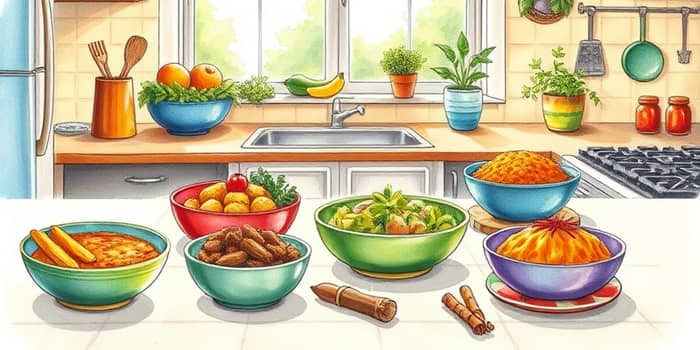Leftovers are more than just reheated meals—they’re a canvas for culinary innovation and environmental stewardship.
Benefits of Embracing Leftovers
Transforming yesterday’s dinner into today’s masterpiece yields powerful advantages for your wallet, your health, and the planet.
- save money on groceries by stretching every ingredient
- reduce household food waste and lighten your environmental impact
- inspire creative kitchen experiments that delight your taste buds
- promote healthier, more balanced meals with added vegetables and grains
Beyond these tangible perks, working with leftovers builds confidence and encourages you to trust your palate and intuition.
Creative Techniques to Reinvent Leftovers
From savory soups to crisp salads, the possibilities are endless when you approach leftovers with intention and flair.
Use this table as a starting point, then adapt seasonings and textures to suit your cravings. A splash of vinegar or a sprinkle of fresh herbs can breathe new life into familiar flavors.
Practical Tips for Zero-Waste Cooking
Successful leftover reinvention often hinges on small strategies that become second nature over time.
- sweeping the kitchen approach: survey all ingredients before planning meals
- batch cooking and freezing: prepare large pots of chili or stew for future use
- flavor-forward additions: keep a stash of spices, vinegars, and condiments
- portion management habits: cook only what you need, save extras for planned reinventions
- odd fruits and veggies: freeze overripe bananas or stale bread for smoothies and puddings
By incorporating these habits into your routine, you’ll minimize waste and maximize enjoyment without extra effort.
Remember, some dishes like casseroles, soups, and baked pastas often taste even better the next day, making them perfect candidates for batch preparation.
Global Inspiration for Flavor
Tapping into international cuisines can spark fresh ideas and introduce new ingredients to your leftover repertoire.
- Larb bowls from Southeast Asia: combine shredded meat with herbs, lime, and chili
- Tinga tacos from Mexico: simmer shredded chicken or pork in chipotle-adobo sauce, serve with crema
- Japanese rice bowls: top steamed rice with fish trimmings, pickles, and soy-based sauces
Exploring these dishes encourages you to experiment with spices, hot sauces, and fresh garnishes you might not typically use.
Emulating global techniques also broadens your flavor palette and helps you appreciate how different cultures honor their ingredients.
Elevating Nutrition and Presentation
Leftover-based meals can be both nourishing and visually appealing when approached thoughtfully.
Add fresh leafy greens, toasted nuts, or a dollop of yogurt to boost texture and nutrition. A sprinkle of toasted seeds or a swirl of flavored oil will make your dish feel gourmet.
Combine colorful vegetables like roasted peppers, carrots, or beets with grains for a salad that delights the eyes as much as the palate.
Don’t shy away from layering colors and textures—crunchy, creamy, and tender elements create memorable mouthfeel and encourage mindful eating.
Empowerment Through Improvisation
Cooking with leftovers is a skill that grows with practice. As you learn to trust your instincts, you’ll discover personal twists that become signature to your table.
Host a friendly challenge with family or friends: give everyone the same set of leftovers and compare creations. This playful exercise heightens creativity and highlights unexpected pairings.
Over time, you’ll accumulate a mental library of pairings—perhaps a paprika-scented potato hash, a turmeric-infused soup, or a berry crumble built on cake scraps.
Conclusion
Transforming leftovers into your best meals is an act of creativity, sustainability, and self-care. By adopting simple strategies, exploring global flavors, and experimenting with textures, you’ll develop a versatile cooking style that honors every ingredient.
Embrace the journey of zero-waste cooking, and let each meal be an opportunity to innovate, nourish, and delight. Your future self—and the planet—will thank you.
References
- https://cosmoappliances.com/how-to-use-leftovers-creatively-reducing-waste-in-the-kitchen/
- https://www.feedingamerica.org/hunger-blog/sweep-kitchen-recipe-ideas-reduce-food-waste
- https://food52.com/hotline/13082-creative-uses-for-leftovers
- https://www.ice.edu/blog/learning-love-leftovers
- https://www.hennepin.us/choose-to-reuse/tips/leftover-ideas
- https://www.everydaycheapskate.com/34-ways-to-make-meals-from-leftovers/
- https://www.helpguide.org/wellness/nutrition/healthier-fast-food
- https://www.bbcgoodfood.com/recipes/collection/leftovers-recipes










